By: Rick Brettell, Art Critic via Dallas News
David Bates is without question Dallas’ most venerated artist and, at 61, definitely worthy of a serious museum reappraisal.

This oil on canvas is titled, 'Galveston Bay', 1989 hangs at the entrance to David Bates exhibit at The Modern Art Museum of Fort Worth.
Artists often have mixed feelings about such things, since so many significant retrospectives have the aura of museum funerals rather than progress reports. So, it was with a bit of trepidation that David Bates, whose work has found its way into important collections from New York to Hawaii, said OK to a two-museum retrospective of his career at the Modern Art Museum of Fort Worth and the Nasher Sculpture Center in Dallas.
Although the hour drive between the two parts of the retrospective is a bit of a chore, there are advantages to the split. One is that they can be viewed on different days and different times, with the second benefiting from the viewer’s mental marination of the first.
The Fort Worth exhibition is devoted, in the main, to Bates’ best known and most ambitious paintings from the early 1980s to the present. Also included are two relief sculptures, one table sculpture and two large drawings. These are installed with lots of space and gorgeous lighting in Tadao Ando’s large, neo-modernist galleries. The intended effect does have a certain memorial quality, allowing us to measure the full effect of the painter’s ambitions over decades.
We’re presented with a regional visual world that is decidedly pre-modern. No oil wells, skyscrapers, freeways, cars, billboards or other contemporary detritus are allowed. It is also a watery world — and in this, very unlike Dallas. Bates evokes swamps, tides, floods, waves and the slippery fish and snakes that survive in water as well as the birds that nest in swamp trees or fly over oceans.
His people are almost exclusively male and of all races. But none of them have much money, and none would be caught dead in a museum. His only other subjects are himself, with a room of resolutely impersonal self-portraits, and a generic woman who reclines or stands as if a model for Matisse or Picasso. These paintings are about a time as thick as the paint, far from the rapidly moving urban capitalist present of contemporary North Texas.
The Nasher Sculpture Center exhibition is devoted to Bates’ sculpture, 50 of which are featured, along with a good many sketches, framed drawings, paintings and working models. Unlike the Modern’s, the installation is crowded, nervous and exciting, with much more the feeling of a progress report. Bates’ presence is palpable, particularly in the lower-floor gallery. He seems to cut, chisel, draw, paint, nail, glue and assemble, as if working in several media at the same time.
Although Bates did make sculpture early in his career, these works were private, and it was not until 1992, a decade after his maturity as a painter, that he began to make an annual trek to Walla Walla, Wash., where he worked in its famous foundry, making assemblages of wood, cardboard, wire, plaster and scrap metal that were cast into bronze.
When the founders finished the casting, Bates took up brushes of animal hair and wire to patinate and paint their surfaces, most often producing a unique painted bronze rather than the customary small edition of identical works patinated by the foundry. Thus, many of these are as much paintings as they are sculptures.
With his love of thick, viscous oil paint, his paintings often verge on relief sculptures, so confident he is in their sheer materiality. This back-and-forth dance between painting and sculpture is one of the most important aspects of artistic modernism, and Bates is well aware of the great tradition of modern painters who sculpt, from Daumier and Degas through Matisse and Picasso to Willem de Kooning and Barnett Newman.

Dallas artist David Bates stands in front of one of one of his oil paintings at The Modern Art Museum of Fort Worth on Saturday, February 8, 2014
More recently, Bates has discovered a much smaller foundry in Houston, to which he can drive back and forth in a day and with whom he enjoys a more intimate working relationship than that in Walla Walla. The bronzes from Houston are, for that reason, more experimental and exciting.
The double exhibition goes a fair distance to validating Bates’ career. It brokers no comparison, including only his work and leaving its art-historical context to the viewers.
Its catalog includes a short interview between Bates and Michael Auping, chief curator of the Modern, and an essay by the Nasher’s director, Jeremy Strick, which does bring up others: Degas, Cézanne, van Gogh, Picasso, Matisse and the American, Marsden Hartley. But these are in passing and, sadly, there is no sustained discussion of the effectiveness of Bates’ most obvious quotations, particularly those of van Gogh, Matisse, Picasso and Hartley. (His two reclining nude bronzes in the Nasher show could almost be considered pastiches of Matisse bronzes.)
The nagging question of his career — his persistent Texas-based regionalism and its roots in Texas art of the 1930s — is raised only in the interview, a little defensively. Yet, it is clear that Bates has simply no interest in the preoccupations — formal, philosophical and political — of many artists of his generation. He mentions Vito Acconci and Bruce Nauman and clearly knows the history of postwar art, but there are no parallels with their output.
In suggesting that his work stems from the great art of the late 19th and early 20th centuries, the exhibition and its catalog provide too few opportunities to consider Bates in the context of his own time.
On the approach to the show at the Modern, a lone painting confronts us on a concrete wall: a tall, virile man standing in the sea wrestling with a large fish. The very act of wrestling with something that moves and writhes is an apt metaphor for Bates’ idea of art. That idea is better understood at the Nasher than at the Modern.
Rick Brettell holds the Margaret McDermott distinguished chair at the University of Texas at Dallas.
Plan your life
“David Bates” continues through May 11 at the Modern Art Museum of Fort Worth, 3200 Darnell St., and Nasher Sculpture Center, 2001 Flora St., Dallas. Modern: Hours 10 a.m. to 5 p.m. Tuesdays-Thursdays, Saturdays-Sundays and 10 a.m. to 8 p.m. Fridays. $10; discounts apply. 817-738-9215. themodern.org. Nasher: Hours 11 a.m. to 5 p.m. Sundays, Tuesdays-Saturdays. $10; discounts apply. 214-242-5100. nashersculpturecenter.org.
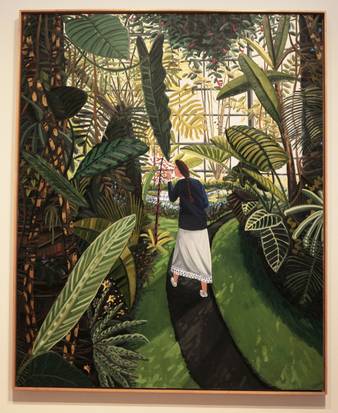
This oil on canvas is titled, "The Conservatory," 1989, by Dallas artist David Bates. The Modern Art Museum of Fort Worth and the Nasher Sculpture Center, Dallas, present a joint exhibition of his work on view February 9th through May 11, 2014. The exhibition is a retrospective of Bates's work installed in both locations with an emphasis on painting in Fort Worth and sculpture and works on paper in Dallas. This is the first collaboration between the two museums. Shot on Wednesday, February 12,2014. David Woo/Staff Photographer
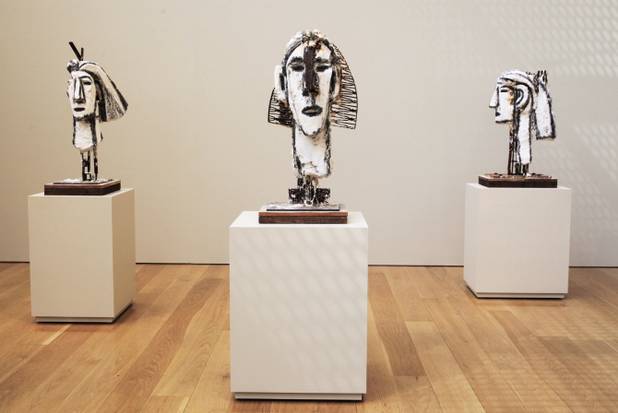
The series of plaster heads began in 1995 are on display at the Nasher Sculpture Center. David Bates was active at the Walla Willa Foundry in rural Washington. In 2002, Bates returned to the medium of plaster and stoic expressions recall ancient Egyptian busts, as well as Pablo Picasso's plaster heads of the 1930s. Shot on Wednesday, February 12,2014. David Woo/Staff Photographer
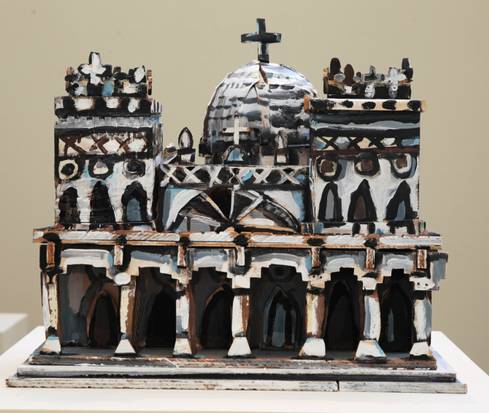
This painted wood and metal piece titled, Sacred Heart Church #2, 1998, is on display at the Nasher Sculpture Center in Dallas. The Modern and the Nasher Sculpture Center, present a joint exhibition of the work of artist David Bates, of Dallas, on view February 9 through May 11, 2014. The exhibition is a retrospective of Bates’s work installed in both locations with an emphasis on painting in Fort Worth and sculpture and works on paper in Dallas. This is the first collaboration between the two museums. Shot on Wednesday, February 12, 2014. David Woo/Staff Photographer
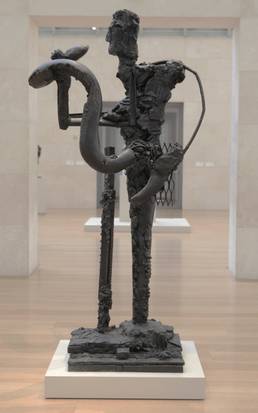
This bronze sculpture titled, "Man with Snake III", 2000-01, is on display at the Nasher Sculpture Center in Dallas. The Modern and the Nasher Sculpture Center, present a joint exhibition of the work of artist David Bates, of Dallas, on view February 9 through May 11, 2014. The exhibition is a retrospective of Bates's work installed in both locations with an emphasis on painting in Fort Worth and sculpture and works on paper in Dallas. This is the first collaboration between the two museums. Shot on Wednesday, February 12,2014. David Woo/Staff Photographer
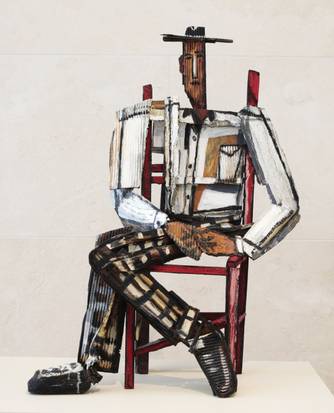
This painted bronze titled, "Man in Red Chair", 1994, is on display at the Nasher Sculpture Center in Dallas. The Modern and the Nasher Sculpture Center, present a joint exhibition of the work of artist David Bates, of Dallas, on view February 9 through May 11, 2014. The exhibition is a retrospective of Bates's work installed in both locations with an emphasis on painting in Fort Worth and sculpture and works on paper in Dallas. This is the first collaboration between the two museums. Shot on Wednesday, February 12, 2014. David Woo/Staff Photographer

David Mitchell Dillard of Dallas studies the work of Dallas artist David Bates on Wednesday, February 12, 2014. The title of the painting, 'Katrina Portrait VII (Buddy)", 2006.The Modern Art Museum of Fort Worth and the Nasher Sculpture Center, Dallas, present a joint exhibition of his work on view February 9th through May 11, 2014. The exhibition is a retrospective of Bates's work installed in both locations with an emphasis on painting in Fort Worth and sculpture and works on paper in Dallas. This is the first collaboration between the two museums.

Jayson Oh, left, and Meri Park of Dallas look at the work of Dallas artist David Bates on Wednesday, February 12, 2014. The Modern Art Museum of Fort Worth and the Nasher Sculpture Center, Dallas, present a joint exhibition of his work on view February 9th through May 11, 2014. The exhibition is a retrospective of Bates's work installed in both locations with an emphasis on painting in Fort Worth and sculpture and works on paper in Dallas. This is the first collaboration between the two museums. David Woo/Staff Photographer
